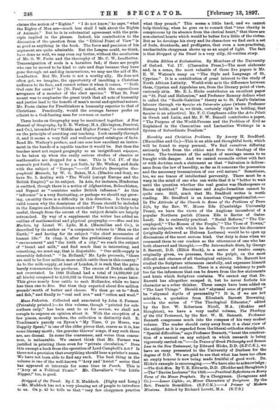Three books on Geography may be mentioned together. A New
Manual of Geography, by E. R. Wethey, M.A. (Rivington, Percival, and Co.), intended for "Middle and Higher Forms," is constructed on the principle of assisting oral teaching. Look casually through it, and it seems a very full and well-arranged catalogue of facts. Read Mr. Wethey's preface, and one sees how excellent an instru- ment in the hands of a capable teacher it would be. But then the teacher must not regard geography as an insignificant xdperyov, to be taken up when the really serious studies of classics or mathematics are dropped for a time. This is Vol. IV. of the manuals put forth, or to be put forth, by Mr. Wethey, and deals with the subject of "Europe."—Of Blackie's Descriptive Geo- graphical Manuals, by W. G. Baker, M.A. (Blackie and Son), we have No. 5, dealing with "The World (except Europe and the British Empire)" as its subject. In Asia, for instance, Hindos tan is omitted, though there is a notice of Afghanistan, Beloochistan, and Nepaul as "countries under British influence." As this "influence" is a very fluctuating, or perhaps we should say grow- ing, quAntity there is a difficulty in this direction. Is there any valid reason why the dominions of the Nizam should be included in the Empire and Beloochistan excluded ? The book is likely to be useful, though from the extent of the subject details are largely retrenched. By way of a supplement the writer has added an outline of mathematical and physical geography. —Man and his Markets, by Lionel W. Lyde, M.A. (Macmillan and Co.), is described by its author as "a companion volume to 'Man on the Earth,' " and having for its subject "the chief necessaries of human life." In chap. 3, after the preliminary discussion of " environment " and "the birth of a city," we reach the subject of "bread and milk," and find much that is interesting, and something, we must say, that is disputable. "Our milk-supply is miserably deficient." "In Holland," Mr. Lyda proceeds, "there are said to be four million more milch cattle than in this country." As to the milk-supply, at least of London, it is such that the price barely remunerates the producer. The excess of Dutch cattle is not overstated. In 1888 Holland had a total of 14,939,000 (of all kinds) compared to 6,508,632 in Great Britain two years later. This gives nearly four cattle to each Hollander, while we have less than one to five. But then they exported about fire million pounds'-worth of butter and cheese. We then go on to "flesh and fish," and finally to "coal and iron" and "cotton and wool."


































 Previous page
Previous page